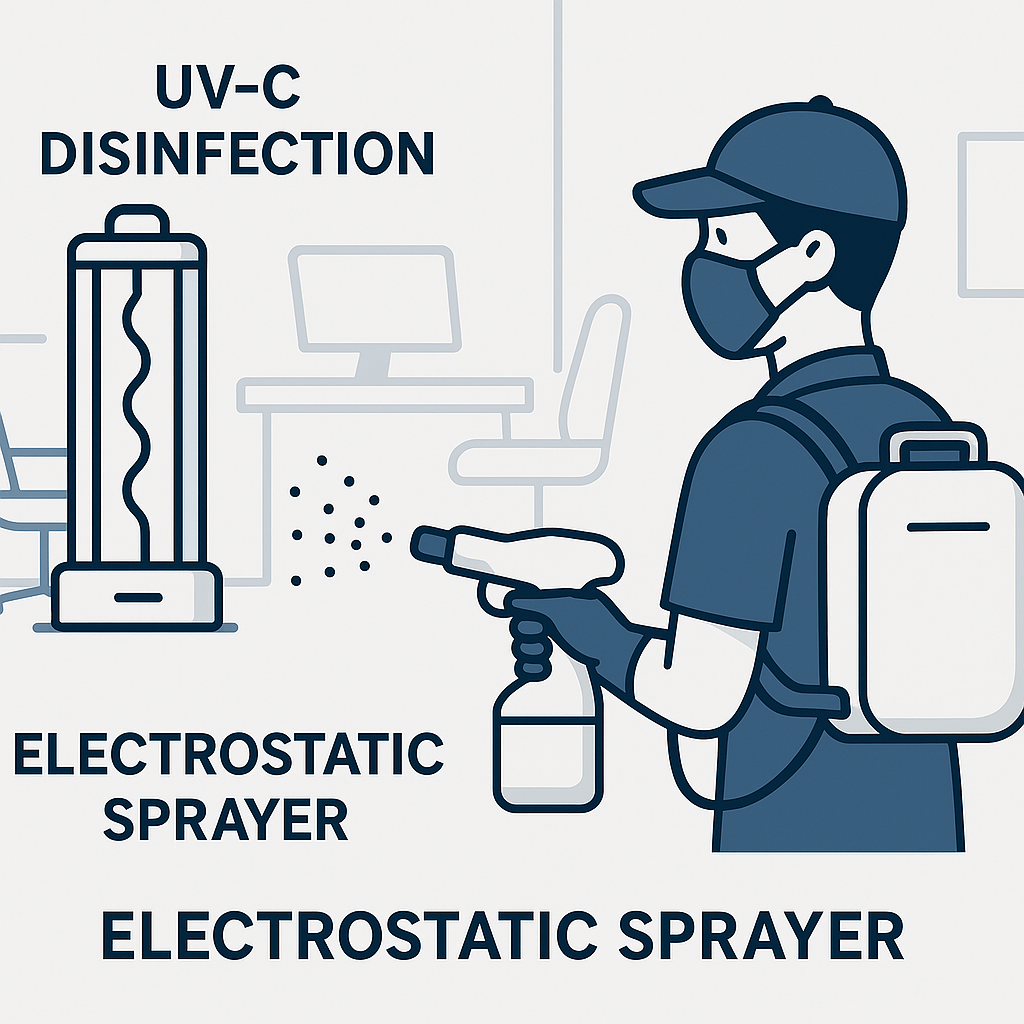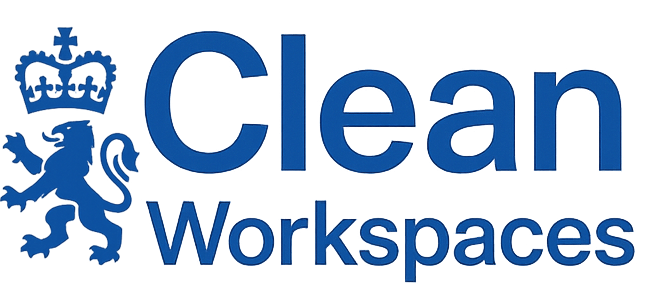Technology-Enhanced Cleaning Solutions
Exploring innovative approaches that are transforming workplace hygiene practices

The cleaning industry is experiencing a technological revolution that promises to fundamentally change how workplace environments are maintained. From robotics and UV light disinfection to advanced microfiber technologies and data-driven cleaning management, these innovations are enhancing both the efficiency and efficacy of cleaning operations while addressing emerging health concerns.
The Evolving Landscape of Workplace Cleaning
Several factors are driving the rapid adoption of technology-enhanced cleaning solutions:
- Heightened hygiene expectations: Post-pandemic awareness has permanently elevated cleanliness standards
- Labor challenges: Cleaning providers face staffing shortages and high turnover rates
- Focus on sustainability: Organizations are seeking reduced environmental impact from cleaning operations
- Evidence-based hygiene: Growing demand for verification of cleaning results rather than simple process compliance
- Cost pressures: Need for greater operational efficiency without sacrificing quality
According to our economic impact research, organizations implementing technology-enhanced cleaning solutions report an average 27% increase in cleaning efficiency alongside a 36% improvement in occupant satisfaction with environmental cleanliness. These dual benefits make the business case for technology adoption increasingly compelling.
Advanced Surface Disinfection Technologies
Traditional manual disinfection, while effective when properly executed, faces challenges with consistency, surface coverage, and chemical exposure risks. Several innovative technologies are addressing these limitations:
UV-C Light Disinfection
Ultraviolet-C (UV-C) light technology has emerged as a chemical-free approach to surface and air disinfection, using short-wavelength ultraviolet light to destroy microorganisms by damaging their DNA/RNA.
Application Methods
- • Portable UV-C units: Mobile systems that can be positioned in different spaces
- • Fixed UV-C installations: Ceiling or wall-mounted systems for regular treatment of specific areas
- • UV-C robots: Autonomous units that navigate spaces, providing comprehensive coverage
- • UV-C chambers: Enclosed systems for disinfecting smaller items like equipment or mobile devices
Key Considerations
- • Safety protocols: UV-C light can be harmful to humans, requiring strict safety measures
- • Surface compatibility: Some materials may degrade with regular UV-C exposure
- • Shadow areas: Light must directly reach surfaces to be effective
- • Dosage requirements: Different pathogens require varying exposure times/intensities
UV-C technology is particularly valuable in high-risk environments and areas with sensitive electronics where chemical disinfectants pose risks. Implementation should follow appropriate disinfection protocols with verification of efficacy.
Electrostatic Spraying Systems
Electrostatic technology applies an electrical charge to disinfectant solutions as they're sprayed, causing the droplets to be attracted to surfaces with an opposite charge. This creates a comprehensive, uniform coating even on complex or hard-to-reach surfaces.
Electrostatic Efficiency
Electrostatic application typically uses 65-85% less disinfectant solution while achieving better coverage than traditional spray methods. This dramatically reduces chemical usage while improving disinfection outcomes.
Implementation considerations include proper training, selection of compatible disinfectants (not all solutions work effectively with electrostatic technology), and establishing appropriate dwell times for effective pathogen elimination.
Electrostatic technology particularly shines in complex environments with irregular surfaces and areas where rapid treatment is required. It can be integrated into seasonal cleaning protocols as an efficient response to increased illness risks during winter months.
Antimicrobial Surface Technologies
Rather than periodic disinfection, these technologies provide continuous protection through surfaces that actively inhibit microbial growth:
- Embedded antimicrobials: Materials manufactured with built-in antimicrobial properties
- Surface coatings: Applied treatments that create an inhospitable environment for microorganisms
- Self-cleaning surfaces: Materials that use photocatalytic reactions to break down organic matter
- Copper alloy surfaces: Utilizing the natural antimicrobial properties of copper in high-touch elements
While traditional cleaning is still required to remove visible soil, these technologies provide ongoing protection between cleanings. Effective implementation requires carefully selecting appropriate applications, with high-touch surfaces being primary candidates.
For guidance on how to integrate these technologies with green cleaning initiatives, see our eco-friendly cleaning supplies article, which includes a section on compatible innovations.
Robotics and Automation in Cleaning
Robotic cleaning solutions are rapidly evolving from novelties to mainstream operational assets, with several categories now proving their value in commercial environments:
Autonomous Floor Care
Robotic scrubbers, vacuums, and sweepers that navigate spaces independently, performing routine floor maintenance tasks.
Key Benefits:
- • Consistent performance regardless of staffing
- • Ability to operate during off-hours
- • Detailed cleaning documentation for verification
- • Reduced labor requirements for routine tasks
Disinfection Robots
Autonomous units deploying UV-C light, hydrogen peroxide vapor, or electrostatic spray technologies for comprehensive room disinfection.
Key Benefits:
- • Consistent application of disinfection protocols
- • Access to difficult-to-reach areas
- • Reduced chemical exposure for cleaning staff
- • Detailed digital documentation of treatments
Successful integration of robotics requires thoughtful implementation rather than simply deploying technology and expecting immediate results. Organizations should:
- Begin with thorough space assessment to identify suitable applications
- Invest in proper staff training on robot operation and maintenance
- Develop clear workflows that integrate robotic and human cleaning activities
- Implement performance tracking systems to quantify benefits
- Establish regular maintenance protocols to ensure consistent operation
The most successful implementations utilize robots for routine, repetitive tasks while redirecting human resources to more complex cleaning requirements and quality assurance functions. This approach, combined with intelligent scheduling as outlined in our workplace hygiene policy guide, maximizes the return on technology investment.
Case Study: Office Complex Implementation
A London-based office complex with 45,000 square meters of floor space implemented a combined approach of autonomous vacuum robots for evening carpet maintenance and electrostatic spraying for weekend disinfection. Key outcomes included:
- 28% reduction in labor hours dedicated to routine floor care
- 19% increase in measurable cleanliness metrics based on ATP testing
- 68% improvement in occupant satisfaction with facility cleanliness
- 22% reduction in total chemical usage through more efficient application
IoT and Smart Cleaning Management
Internet of Things (IoT) technologies are transforming cleaning from calendar-based routines to data-driven, needs-based operations:
Occupancy-Based Cleaning Systems
Rather than fixed schedules, these systems use real-time occupancy data to determine cleaning needs:
- Sensor networks: Detecting actual usage patterns of spaces and facilities
- Traffic monitoring: Triggering cleaning interventions based on predetermined usage thresholds
- Predictive scheduling: Using historical data to anticipate cleaning needs
- Real-time deployment: Directing cleaning staff to areas of immediate need
These approaches significantly improve resource allocation while ensuring that high-traffic areas receive appropriate attention. They're particularly valuable in facilities with variable occupancy patterns, as discussed in our workplace hygiene in flexible working article.
Smart Dispensing and Monitoring
Connected dispensing systems provide data-driven management of cleaning supplies and hygiene consumables:
- Soap and sanitizer monitoring: Real-time alerts when dispensers need refilling
- Paper product management: Usage tracking and replenishment notifications
- Chemical dilution systems: Precise mixing with digital monitoring for consistency
- Usage analytics: Identifying consumption patterns and optimization opportunities
These systems eliminate both wasteful premature replacements and service disruptions from depleted supplies. They also provide valuable data for forecasting and budgeting purposes.
Digital Cleaning Management Platforms
Comprehensive software platforms are digitizing cleaning operations management:
- Mobile task assignment: Digital distribution of cleaning responsibilities
- Digital verification: Photographic or QR-code based completion confirmation
- Quality inspection tools: Structured assessment protocols with scoring systems
- Performance analytics: Tracking cleaning metrics across time and locations
- Automated reporting: Generating compliance documentation and trend analysis
These platforms enhance accountability while providing the detailed documentation increasingly required for compliance and quality assurance purposes, aligning with the verification methods detailed in our surface testing methods article.
Advanced Air Quality Management
While surface cleaning traditionally receives the most attention, air quality technologies are increasingly recognized as essential components of comprehensive hygiene programs:
Advanced Filtration Systems
- HEPA filtration: High-efficiency particulate air filters capturing 99.97% of particles ≥0.3 microns
- Activated carbon systems: Addressing gaseous pollutants and odors
- MERV-13+ rated filters: Enhanced filtration for existing HVAC systems
- Filter monitoring systems: Real-time performance tracking and replacement indicators
Active Air Treatment Technologies
- Upper-room UV-C systems: Continuous disinfection of air in occupied spaces
- Bipolar ionization: Creating charged particles that agglomerate contaminants for easier filtration
- Photocatalytic oxidation: Using UV light and catalyst materials to break down pollutants
- Portable air purification: Deployable units for targeted air quality management
Air quality technologies are particularly important in densely occupied spaces, areas with limited natural ventilation, and facilities where aerosol transmission of pathogens is a concern. For detailed guidance on implementation, see our ventilation and reduced sick days report, which includes specific technology recommendations.
Practical Implementation Guidance
Organizations considering technology-enhanced cleaning solutions should follow a structured approach to implementation:
- Needs assessment: Identify specific challenges and objectives rather than simply adopting technology for its own sake
- Pilot testing: Implement technologies in limited areas to validate effectiveness before broader deployment
- Integration planning: Develop clear protocols for how technology will complement existing cleaning programs
- Staff training: Ensure cleaning teams understand both operation and purpose of new technologies
- Performance measurement: Establish clear metrics to evaluate impact and return on investment
- Ongoing optimization: Continuously refine implementation based on performance data and feedback
The most successful implementations take a phased approach, allowing for learning and adjustment rather than attempting wholesale transformation. This approach aligns with principles outlined in our workplace hygiene policy guide, which emphasizes systematic implementation of new protocols.
Conclusion: A Strategic Approach to Technology
Technology-enhanced cleaning solutions offer significant potential benefits for workplace environments, from improved hygiene outcomes and operational efficiency to enhanced sustainability and occupant satisfaction. However, successful implementation requires a thoughtful, strategic approach rather than simply acquiring the latest innovations.
Organizations should:
- Identify specific operational challenges that technology can address
- Evaluate solutions based on their specific facility requirements and constraints
- Consider total cost of ownership, including maintenance and operational impacts
- Develop comprehensive implementation plans that include staff training and process integration
- Establish clear performance metrics to evaluate effectiveness and ROI
By taking this strategic approach, organizations can leverage cleaning technology to create healthier, more efficient workplace environments while avoiding costly implementation failures. For assistance evaluating specific technologies for your facility, contact our consulting team for personalized guidance.
Related Articles
Surface Testing Methods: Ensuring Cleaning Efficacy
Verification techniques to confirm your cleaning protocols are achieving results.
Infection Control Best Practices for High-Traffic Facilities
Specialized hygiene protocols for managing transmission risks in busy environments.
Choosing Eco-Friendly Cleaning Supplies for Your Business
A guide to selecting environmentally friendly cleaning products.
Technology Assessment
Need help evaluating which cleaning technologies would provide the best ROI for your specific facility? Our consulting team offers technology assessment services tailored to your operational needs.
Request Consultation